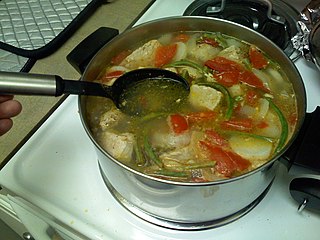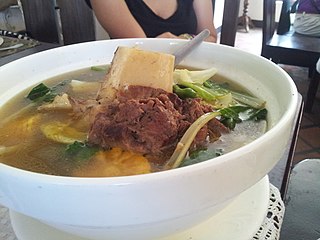
Laksa is a spicy noodle dish popular in Southeast Asia. Laksa consists of various types of noodles, most commonly thick rice noodles, with toppings such as chicken, prawn or fish. Most variations of laksa are prepared with a rich and spicy coconut soup or a broth seasoned with sour asam.

Sinigang is a Filipino soup or stew characterized by its sour and savory taste. It is most often associated with tamarind, although it can use other sour fruits and leaves as the souring agent. It is one of the more popular dishes in Filipino cuisine. The soup is usually accompanied by rice. In 2021, sinigang was rated as the world's best vegetable soup by TasteAtlas.

The generic term for condiments in the Filipino cuisine is sawsawan. Unlike sauces in other Southeast Asian regions, most sawsawan are not prepared beforehand, but are assembled on the table according to the preferences of the diner.

Thai curry is a dish in Thai cuisine made from curry paste, coconut milk or water, meat, seafood, vegetables or fruit, and herbs. Curries in Thailand mainly differ from the curries in India in their use of ingredients such as herbs and aromatic leaves over a mix of spices.

Javanese cuisine is the cuisine of Javanese people, a major ethnic group in Indonesia, more precisely the province of Central Java, Yogyakarta and East Java.

Laing, is a Filipino dish of shredded or whole taro leaves with meat or seafood cooked in thick coconut milk spiced with labuyo chili, lemongrass, garlic, shallots, ginger, and shrimp paste. It originates from the Bicol Region, where it is known simply as pinangat. Laing is also a type of ginataan, and thus may also be referred to as ginataang laing. Laing is commonly eaten as a vegetable side to complement meat or fish side dishes known as ulam in Filipino, which is normally paired with boiled white rice.

Pinangat na isda, also called pangat na isda, is a Filipino dish from Southern Luzon consisting of fish and tomatoes stewed in a broth soured with fruits like calamansi, bilimbi, tamarind, or santol. It can also be used to cook shrimp. It is similar to sinigang, but it is not as tart.

Bulalô is a beef dish from the Philippines. It is a light colored soup that is made by cooking beef shanks and bone marrow until the collagen and fat has been melted into the clear broth. It typically includes leafy vegetables, corn on the cob, scallions, onions, garlic, ginger, and fish sauce. Potatoes, carrots, or taro can also be added. It is commonly eaten on rice with soy sauce and calamansi on the side. Bulalo is native to the Southern Luzon region of the Philippines, particularly in the provinces of Batangas and Cavite.

Burmese salads are a diverse category of indigenous salads in Burmese cuisine. Burmese salads are made of cooked and raw ingredients that are mixed by hand to combine and balance a wide-ranging array of flavors and textures. Burmese salads are eaten as standalone snacks, as side dishes paired with Burmese curries, and as entrees. The iconic laphet thoke is traditionally eaten as a palate cleanser at the end of a meal.

Paksiw is a Filipino style of cooking, whose name means "to cook and simmer in vinegar". Common dishes bearing the term, however, can vary substantially depending on what is being cooked.

Hot and sour soup is a popular example of Sichuan cuisine. Similar versions are found in Henan province, near Beijing, and in Henan cuisine itself, where it may also be known as hulatang or "pepper hot soup" (胡辣汤). Also popular in Southeast Asia, India, Pakistan and the United States, it is a flexible soup which allows ingredients to be substituted or added depending on availability. For example, the American-Chinese version can be thicker as it commonly includes corn starch, whilst in Japan, sake is often added.

Ginataang kalabasa, also known as kalabasa sa gata, is a Filipino vegetable stew made from calabaza in coconut milk and spices. It commonly includes shrimp and yardlong beans and either bagoong or patis. It can also be cooked with fish, crab, or meat and a variety of other ingredients. It is a creamy umami-laden dish that is naturally slightly sweet due to the calabaza. It is a type of ginataan.

Sinantolan, also known as ginataang santol or gulay na santol, is a Filipino dish made with grated santol fruit rinds, siling haba, shrimp paste, onion, garlic, and coconut cream. Meat or seafood are also commonly added, and a spicy version adds labuyo chilis. It originates from Southern Luzon, particularly from the Quezon, Laguna, and Bicol regions. It is a type of ginataan.

Ginataang isda is a Filipino fish stew made from fish and leafy vegetables in coconut milk with garlic, ginger, onion, patis or bagoong alamang, and salt and pepper. It is a type of ginataan. A common version of the dish, known as ginataang paksiw na isda or paksiw na isda sa gata, is additionally soured with vinegar. Ginataang isda is a type of ginataan.

Ginataang kuhol is a Filipino snail stew made from apple snails in coconut milk with leafy vegetables, onion, garlic, ginger, siling haba chilis, bagoong alamang, and salt and pepper. Labuyo chilis are also commonly added for a spicier version. The leafy vegetables can include water spinach, moringa leaves, and chili pepper leaves, among others.

Sinanglay is a Filipino dish made from stuffed fish wrapped in leafy vegetables and lemongrass or pandan leaves cooked in a spicy coconut milk sauce. It is a type of ginataan and originates from the Bicol Region.

Paklay refers to two different Filipino braised dishes from the Mindanao and Visayas Islands characterized by julienned ingredients. They are eaten with rice or served as pulutan with alcohol.

Tuslob buwa is a Cebuano street food which originated from the barangays of Pasil and Suba in Cebu City.



















